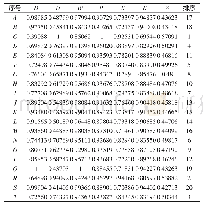《Table 3–Correlations of Euclidean distance (ED) and simple matching distance (SM) with hybrid perfo
 提示:宽带有限、当前游客访问压缩模式
提示:宽带有限、当前游客访问压缩模式
本系列图表出处文件名:随高清版一同展现
《Phenotypic and molecular diversity-based prediction of heterosis in pearl millet(Pennisetum glaucum L.(R.) Br.)》
The basic genetic material for this study comprised two sets of parental lines.The first set(hereafter,referred as Set I)comprised of 213 lines,which involved 98 maintainer parents(designated between 1984 and 2004 at ICRISAT,Patancheru,India)and 115 restorer parents(designated between 1985 and1995 at ICRISAT,Patancheru,India).The second set(hereafter,referred as Set II)comprised of 166 hybrid parents,which comprised 88 maintainer parents and 78 restorer parents bred at ICRISAT,Patancheru,India since 2004.Genotyping data was generated using 38 SSRs for 213 lines in Set I[11]and its subset of 28 SSRs for 166 lines in Set II[12].Genotyping data of both the sets were analyzed using Darwin 5.0[13].The SSRs were highly polymorphic and 30 of them were distributed over all seven linkage groups in earlier studies[14–17](Table 1).A dissimilarity matrix was calculated for pairs of maintainer parents(B lines)×restorer parents(R lines)using simple matching[13].Twenty-two and 29 hybrid combinations were identified for sets I and II,respectively,based on genetic distance between B and R lines.Hybrid combinations were identified,considering that pairs with diverse pedigree parents were selected,and the genetic distances between B and R lines of pairs represented all levels(low,medium and high)of genetic distance.Genetic distance varied from 0.19 to0.90 between B and R lines of Set I and from 0.17 to 0.93 in Set II lines.Seed of these identified hybrid combinations was produced in summer season of 2008(for Set I)and 2009(for Set II).Twenty-two hybrids(20 B×R and 2 R×R)were developed from Set I lines using 20 B lines and 23 R lines.Twenty-nine B×R hybrids were developed from Set II lines using 29 each of maintainer and restorer parents.
| 图表编号 | XD0012322200 严禁用于非法目的 |
|---|---|
| 绘制时间 | 2018.06.01 |
| 作者 | Shashi Kumar Gupta、Thirunavukkarasu Nepolean、Chinna Ghouse Shaikh、Kedarnath Rai、Charles Thomas Hash、Roma Rani Das、Abhishek Rathore |
| 绘制单位 | International Crops Research Institute for the Semi-Arid Tropics (ICRISAT)、International Crops Research Institute for the Semi-Arid Tropics (ICRISAT)、Indian Agricultural Research Institute (IARI)、International Crops Research Institute for the Semi-Arid Tr |
| 更多格式 | 高清、无水印(增值服务) |
查看“Table 3–Correlations of Euclidean distance (ED) and simple matching distance (SM) with hybrid performance, relative mid-”的人还看了
-

- Table 1 Cosmogenic nuclide concentrations and simple burial ages of the vein quartz chunks from artifact layer1 in Liuwa
-

- 表9 20台发动机无量纲处理后欧氏距离和灰色关联度、加权综合无量纲处理K+和K-及相对贴近度δTab.9 The Euclidean Distance and Grey Correlation Degree、Weight Integrate
-

- 表5 6个绒螯蟹群体之间欧氏距离的比较分析Tab.5 Comparison of Euclidean distances (below diagonal) between the six Eriocheir s.s.populations





